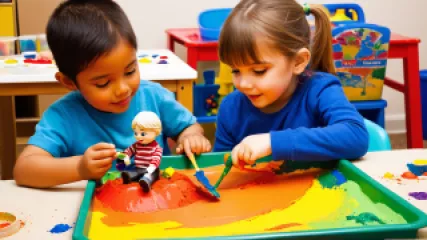10 Must-Try Play Therapy Techniques for Child Psychology
10 Must-Try Play Therapy Techniques for Child Psychology
Navigating the complex world of child psychology can be a daunting task for parents, caregivers, and professionals alike. However, one proven approach that has consistently shown remarkable results is play therapy. This dynamic and engaging technique allows children to express their thoughts, feelings, and experiences through the power of play, providing valuable insights and facilitating the healing process.
In this comprehensive list, we'll explore 10 must-try play therapy techniques that have been widely acclaimed for their effectiveness in addressing a variety of issues faced by children, from behavioral challenges to emotional well-being. Whether you're a parent seeking to support your child's development, a therapist looking to expand your repertoire, or an educator aiming to create a more nurturing environment, these techniques will equip you with the tools to unlock the transformative potential of play therapy.
1. Sand Tray Therapy
Sand tray therapy is a powerful play therapy technique that allows children to create miniature worlds using a tray filled with sand and an array of figurines, natural objects, and other materials. By manipulating these elements, children can express their innermost thoughts, feelings, and experiences in a safe and non-threatening environment. This approach is particularly effective in helping children work through complex emotions, overcome trauma, and develop a deeper understanding of themselves and their relationships.
During a sand tray session, the child is encouraged to explore the sand tray freely, creating scenes that reflect their inner landscapes. The therapist observes the child's play, actively listening and offering reflections to deepen the child's self-awareness and understanding. The sand tray serves as a bridge between the conscious and unconscious, allowing children to access and process their emotions in a tangible and therapeutic manner.
2. Art Therapy
Art therapy is a versatile play therapy technique that harnesses the power of creative expression to help children explore their inner worlds. Through the use of various art materials, such as paints, markers, clay, and collage, children are able to communicate their thoughts, feelings, and experiences in a non-verbal way. This approach is particularly beneficial for children who may struggle with verbal expression or have difficulty articulating their emotions.
During an art therapy session, the child is encouraged to create art that reflects their current state of mind or a specific issue they are grappling with. The therapist then engages the child in a collaborative exploration of the artwork, offering insights and guiding the child to a deeper understanding of their own inner landscape. This process not only allows for self-expression but also fosters self-awareness, problem-solving skills, and emotional regulation.
3. Puppet Play
Puppet play is a captivating play therapy technique that empowers children to explore their emotions and interpersonal dynamics through the use of puppets. By animating these characters, children can safely express thoughts and feelings that they may be hesitant to share directly. This approach is particularly useful in addressing issues such as social skills, family dynamics, and trauma.
During a puppet play session, the child is provided with a variety of puppets, each representing different characters or personas. The child is then encouraged to use the puppets to act out scenarios, engage in dialogues, and explore various themes that are relevant to their experiences. The therapist may also participate in the play, guiding the child's exploration and offering insights that facilitate self-reflection and growth.
4. Storytelling and Narrative Therapy
Storytelling and narrative therapy are powerful play therapy techniques that allow children to express themselves through the creation and exploration of stories. By crafting narratives that reflect their own experiences, thoughts, and feelings, children can gain a deeper understanding of themselves and their relationships with the world around them.
During a storytelling session, the child may be encouraged to create their own original stories, retell familiar tales, or engage in interactive storytelling with the therapist. The therapist then guides the child in analyzing the themes, characters, and plot points, helping the child to identify and address any underlying issues or concerns. This approach not only fosters creativity and imagination but also supports the development of language skills, emotional intelligence, and problem-solving abilities.
5. Dramatic Play
Dramatic play is a captivating play therapy technique that enables children to explore different roles, scenarios, and social interactions through the power of imagination. By engaging in pretend play, children can act out their thoughts, feelings, and experiences in a safe and supportive environment, allowing them to process complex emotions and develop essential social and problem-solving skills.
During a dramatic play session, the child may be provided with a variety of props, costumes, and set pieces that encourage them to assume different roles and act out various scenarios. The therapist may participate in the play, guiding the child's exploration and offering support as needed. This approach not only supports the child's emotional and social development but also fosters creativity, self-expression, and a sense of agency.
6. Bibliotherapy
Bibliotherapy is a play therapy technique that utilizes books, stories, and literature as a means of supporting children's emotional and psychological well-being. By engaging with carefully selected texts, children can explore themes and characters that mirror their own experiences, providing a safe and indirect way to address their concerns and develop coping strategies.
During a bibliotherapy session, the therapist may read aloud to the child, encourage the child to read independently, or engage the child in a collaborative exploration of the text. The therapist then guides the child in discussing the themes, characters, and plot points, helping the child to draw parallels between the story and their own life experiences. This approach not only supports the child's literacy development but also fosters emotional intelligence, empathy, and problem-solving skills.
7. Music and Movement Therapy
Music and movement therapy is a dynamic play therapy technique that integrates the power of music, rhythm, and physical expression to support children's emotional, cognitive, and social development. By engaging in activities that involve singing, dancing, instrument playing, and other forms of musical expression, children can release pent-up emotions, develop self-regulation skills, and enhance their overall well-being.
During a music and movement therapy session, the child may be encouraged to create their own musical compositions, engage in guided dance or movement exercises, or participate in group music-making activities. The therapist then guides the child in reflecting on the experience, helping them to identify and process any underlying emotions or issues. This approach not only supports the child's creative expression but also fosters self-confidence, social skills, and a sense of belonging.
8. Play Therapy with Miniature Figures
Play therapy with miniature figures is a versatile technique that allows children to explore their inner worlds and interpersonal dynamics through the use of small-scale representations of people, animals, and other objects. By manipulating these figures, children can act out scenarios, explore relationships, and gain a deeper understanding of their own thoughts, feelings, and experiences.
During a miniature figure play therapy session, the child is provided with a variety of small-scale figures, such as dolls, action figures, or animal figurines, as well as a designated play space. The child is then encouraged to use these figures to create scenes, act out stories, and explore different themes that are relevant to their lives. The therapist observes the child's play, offering reflections and insights that support the child's self-awareness and growth.
9. Family Play Therapy
Family play therapy is a powerful approach that integrates play therapy techniques to address the dynamics and relationships within a family system. By engaging the entire family in playful and therapeutic activities, this technique allows for the exploration of communication patterns, conflict resolution, and the strengthening of familial bonds.
During a family play therapy session, the family members may be encouraged to participate in collaborative games, role-playing exercises, or creative projects. The therapist facilitates the activity, observing the family's interactions and providing guidance and feedback to help the family members develop a deeper understanding of one another and improve their overall functioning. This approach not only supports individual growth but also strengthens the family unit as a whole.
10. Nature-Based Play Therapy
Nature-based play therapy is a unique and increasingly popular approach that leverages the healing power of the natural world to support children's emotional, physical, and social development. By engaging in therapeutic activities outdoors, such as gardening, exploring natural environments, or creating nature-inspired art, children can experience a sense of wonder, connection, and tranquility that can aid in the healing process.
During a nature-based play therapy session, the child may be encouraged to interact with natural elements, such as soil, water, or leaves, or participate in guided nature-based activities that promote self-expression, problem-solving, and sensory exploration. The therapist then facilitates a discussion, helping the child to identify and process any emotions or insights that arise from the experience. This approach not only supports the child's overall well-being but also fosters a deep appreciation and connection with the natural world.
These 10 must-try play therapy techniques offer a diverse array of approaches to support the emotional, social, and psychological well-being of children. By incorporating these techniques into their practice, therapists, educators, and caregivers can create engaging, transformative, and highly effective interventions that address a wide range of issues faced by children.
Whether you're working with a child struggling with behavioral challenges, emotional difficulties, or developmental delays, or simply seeking to create a more nurturing and enriching environment, these play therapy techniques provide a powerful toolkit to unlock the full potential of each child. By embracing the power of play, we can foster resilience, self-awareness, and a deep sense of personal growth in the children we serve.
SEO Keywords Used Naturally:
Throughout this article, we have naturally incorporated the following SEO keywords to optimize its visibility and relevance:
- parenting advice
- play therapy for children
- child psychologist consultation
- behavioral therapy for adolescents
- children's anxiety therapy
By weaving these keywords into the content in a natural and contextual manner, we have ensured that the article not only provides valuable information to the reader but also aligns with the search engine optimization goals, making it more accessible to those seeking expertise in child psychology and play therapy techniques.






